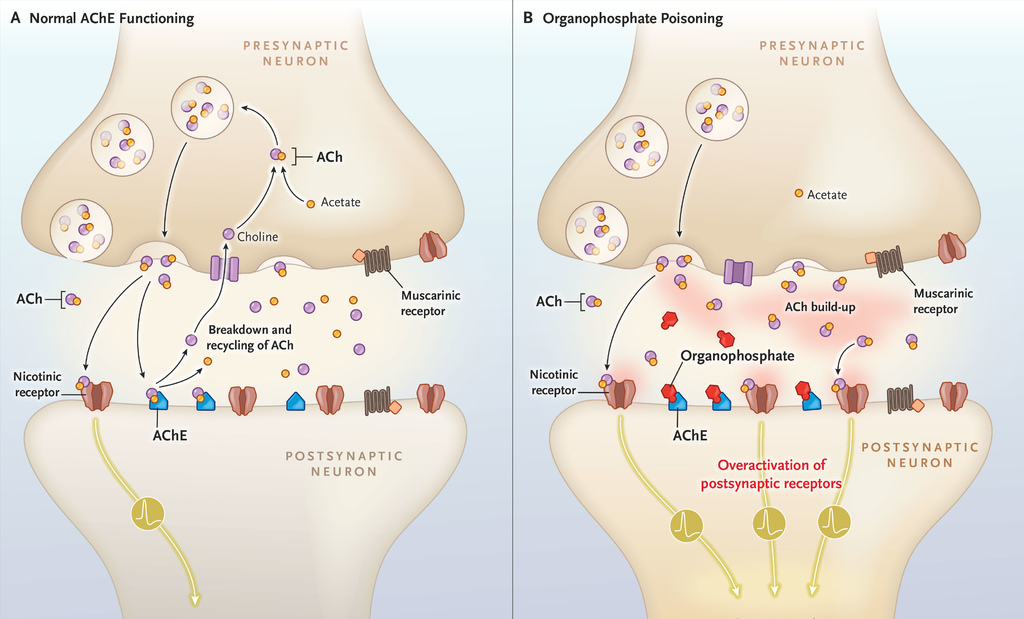What are some of the features of cyanide poisoning?
Hazardous chemical emergencies and related poisonings result from various exposures, including inadvertent residential, industrial, occupational, or transportation mishaps; natural disasters; and hazardous-substance releases that are intended to cause harm.
Clinical Pearls
Q: Is exposure to a respiratory irritant always associated with the immediate onset of symptoms?
A: Exposure to respiratory irritants leads to characteristic toxidromes that are based on the agent’s water solubility. Highly water-soluble chemicals (e.g., ammonia) cause immediate irritant symptoms (burning sensation, tearing, sneezing, rhinorrhea, and cough) from exposed mucous membranes. In contrast to water-soluble compounds, relatively water-insoluble respiratory irritants cause few symptoms or upper-airway signs before delayed-onset acute lung injury is manifested. Inciting agents include oxides of nitrogen (causing silo filler’s disease) and phosgene. Patients may be unaware of exposure, presenting hours to days later with increased sputum production, chest tightness, and dyspnea on exertion.
Q: What agents are included in the class of chemical warfare agents known as vesicants?
A: Although vesicants include nitrogen mustard, lewisite, and phosgene oxime, sulfur mustard is the greatest concern with respect to military and terrorist use. Mustard is an alkylating agent, attacking cellular macromolecules and DNA and irreversibly damaging target tissues on contact, particularly skin, lung, and eye tissues. The eyes are most sensitive to mustard exposure, with red, irritated conjunctiva progressing to blepharospasm and lid edema, corneal ulcerations and in extreme cases, corneal rupture. The systemic toxic effects of mustard exposure are similar to those of chemotherapeutic agents: bone marrow suppression, neutropenia, and subsequent sepsis, mutagenesis, and carcinogenesis.
Morning Report Questions
Q: What are some of the features of cyanide poisoning?
A: Cyanide exposure is associated with inhalation of smoke from house fires; additional sources of exposure include industrial and laboratory accidents, sodium nitroprusside therapy, cyanogenic chemical and plant ingestion, suicide attempts, and criminal or terrorist activity. Cyanide inhibits mitochondrial cytochrome oxidase and thus oxidative phosphorylation, with asphyxiant clinical effects, metabolic acidosis, and hyperlactatemia. An elevated mixed venous oxygen saturation, which is uncharacteristic of many causes of cardiorespiratory compromise, may suggest the diagnosis. Cherry-red skin and bitter-almond breath odor have been described, but these are actually uncommon findings and prone to misattribution. Elevated blood cyanide levels would support the diagnosis, but the test is not available on an emergency basis. In critically ill persons with smoke inhalation, lactate levels above 10 mmol per liter are strongly associated with cyanide toxicity. Three antidotes for the toxic effects of cyanide are currently available in the United States.
Q: What is the action of organophosphates in those exposed?
A: Organophosphates act primarily by inhibiting acetylcholinesterase at neural junctions. Excess synaptic acetylcholine results in the cholinergic toxidrome involving the central nervous system (CNS), neuromuscular junction, and autonomic nervous system. Severe poisonings probably also involve γ-aminobutyric acid and N-methyl-d-aspartate glutamate receptors, exacerbating toxic effects on the CNS. In classic cases, muscarinic, nicotinic, and CNS effects ensue. Lethality is due primarily to respiratory compromise from central apnea, severe airway narrowing, excessive pulmonary secretions, and respiratory muscle paralysis.













 留言列表
留言列表
 線上藥物查詢
線上藥物查詢 